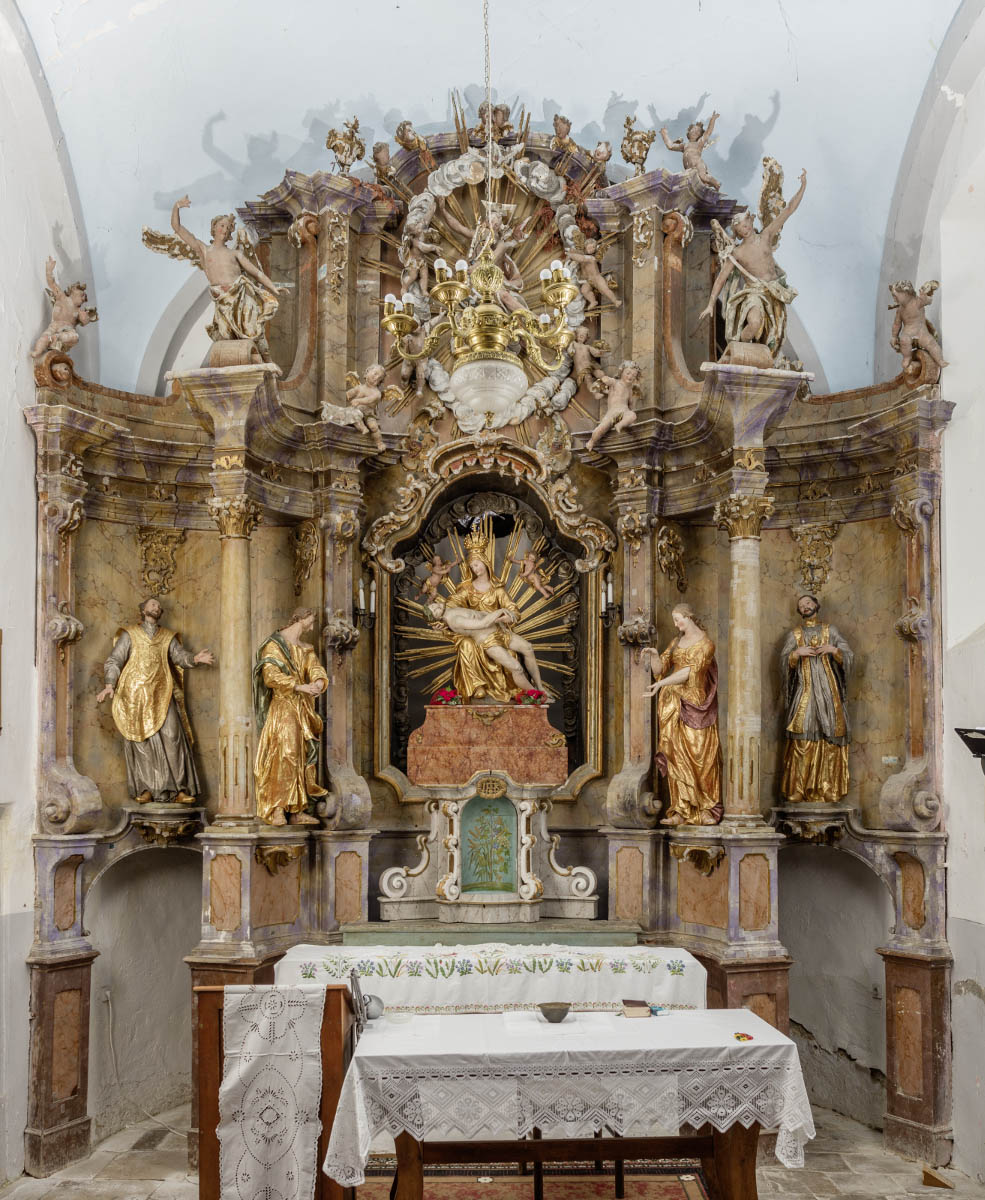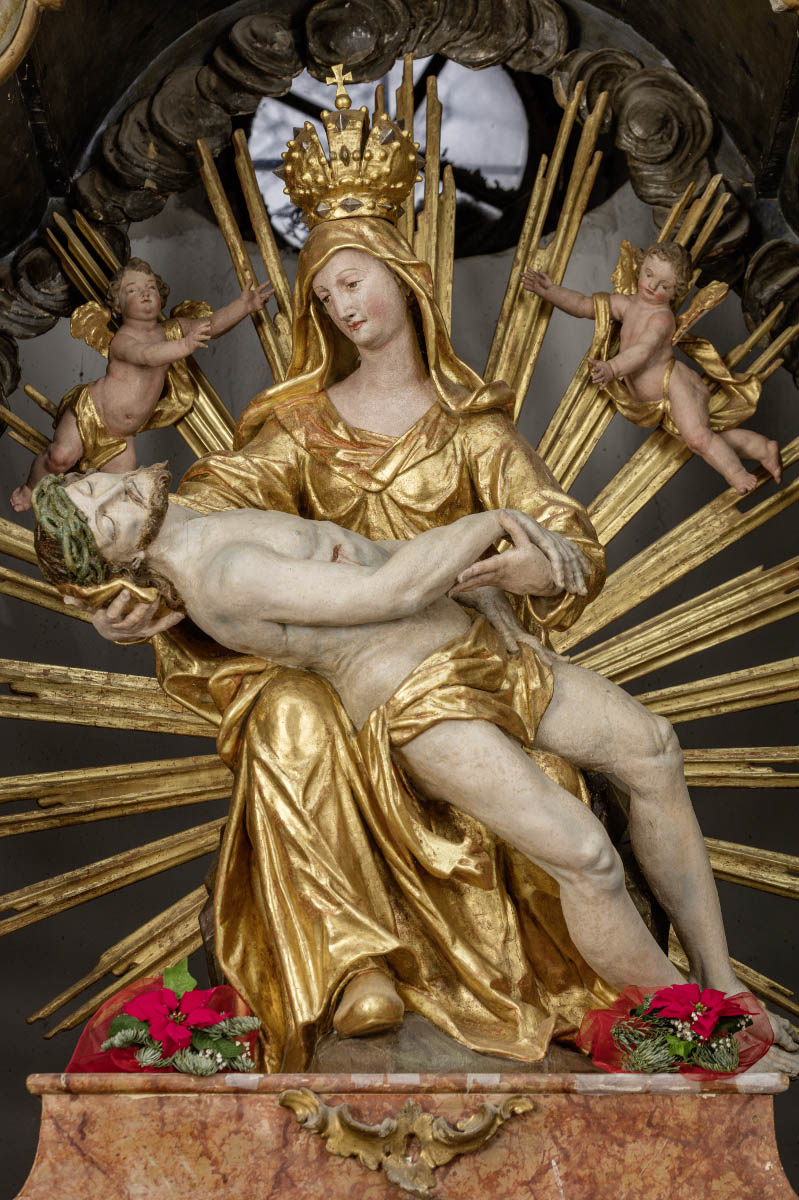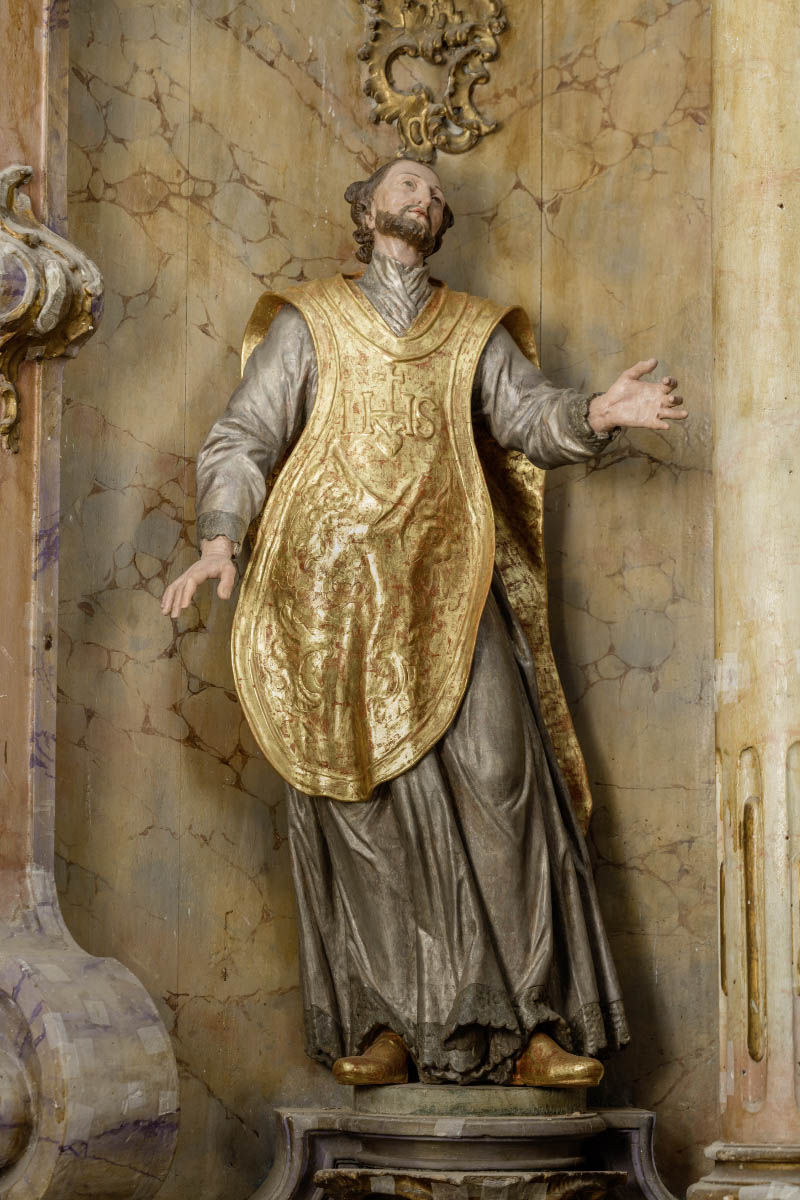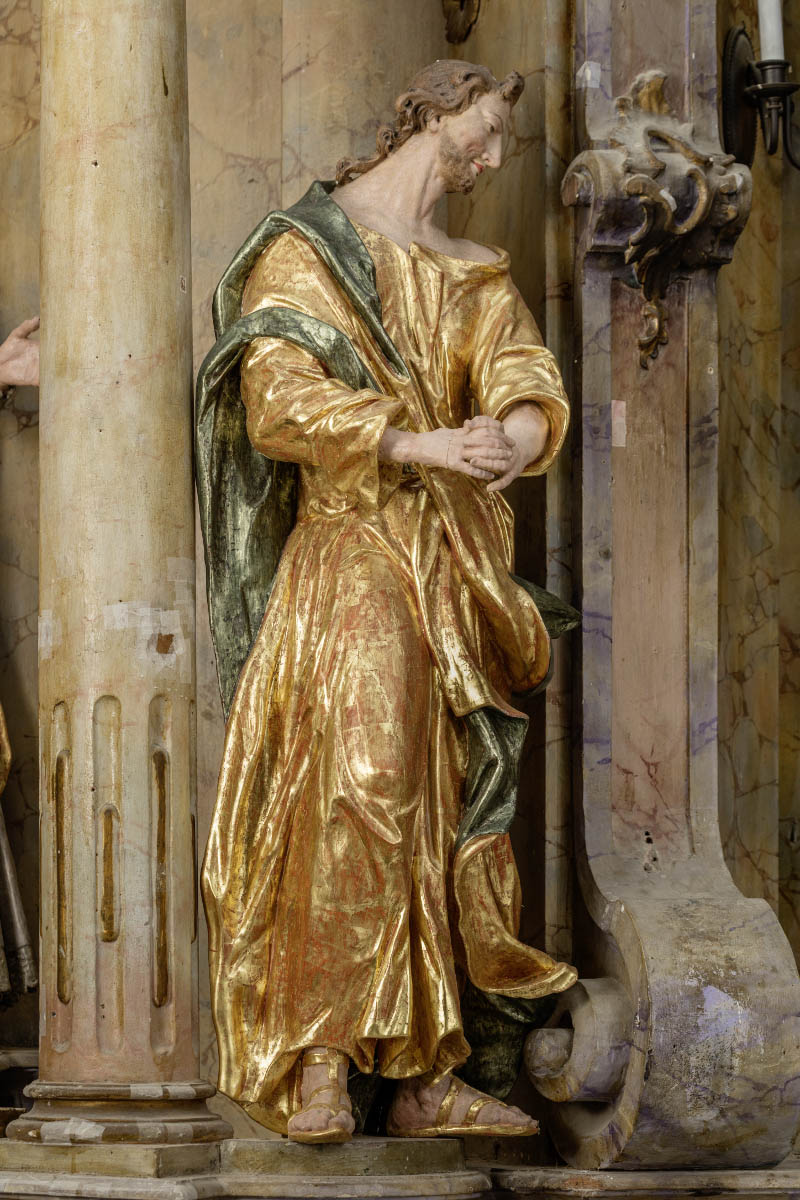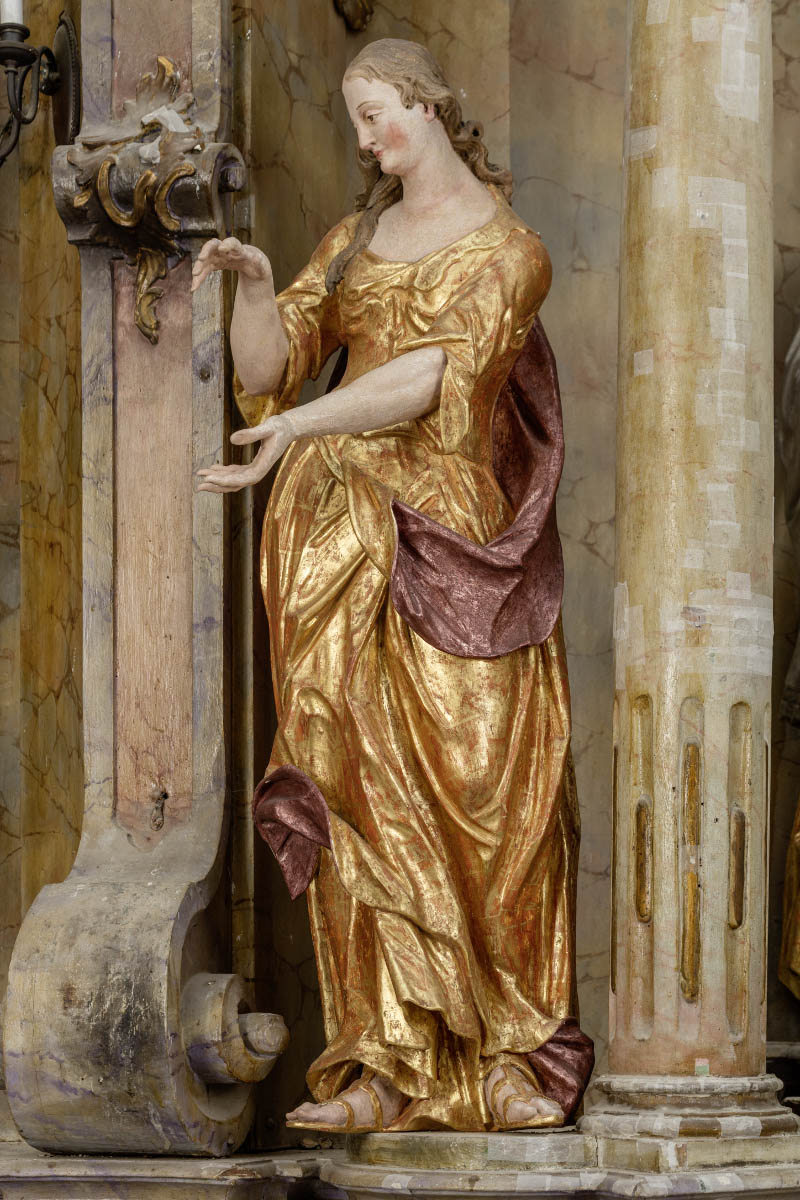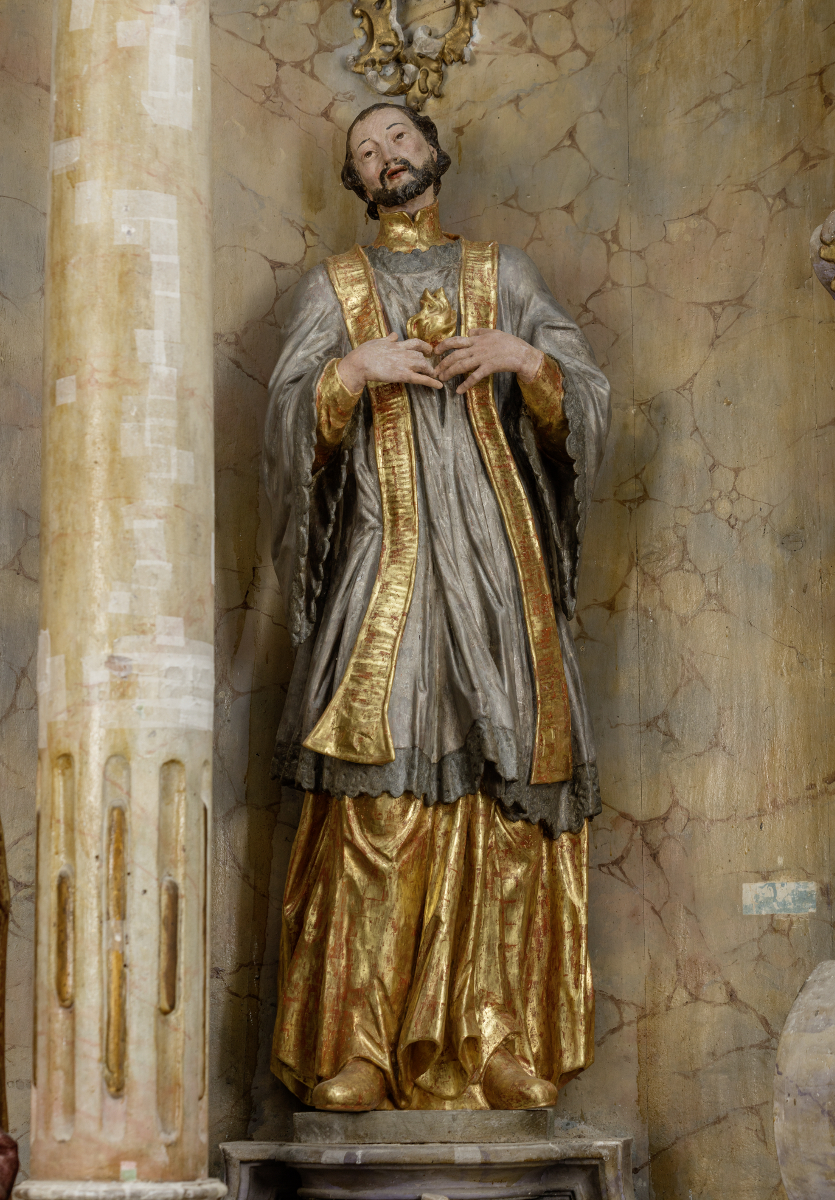Location
Croatia, Zagreb County, Prepolno
Chapel of Our Lady of Seven Sorrows (Kapela Majke Božje od Sedam Žalosti)
Roman Catholic Parish of All Saints in Bedenica
Artwork
The high altar of the Chapel of Our Lady of Seven Sorrows in Prepolno
Type
High altar
Dimensions
Height: 695 cm, width: 523 cm, depth: 173 cm
Inscriptions
- 1764 (on the predella, behind the tabernacle)
Critical History
The high altar was first mentioned in the text of the canonical visitation in 1771,1 which stated that it had been commissioned by the local community and the local patron Ignacije Kašnar, of whom contemporaries had a very low opinion.2 The parish priest Švagel wrote in 1788 that he had paid the debt "of 20 forints to some painter for painting the high altar".3 The sculptures were attributed to Franz Anton Straub by Doris Baričević on the basis of style resemblance to the work of his brothers.4 Nevertheless, unlike ornamental decoration on other altars attributed to Franz Anton Straub, the subtle ornaments with perforated core and curly attenuate edges are shaped in a way more similar to, for example, that of the high altar in Tugonica, where the sculptures were created by another artist.5 Restoration works revealed the date 1764 written on predella behind the tabernacle, thus correcting the date 1768 mentioned in previous literature. 6 According to the similarity in the concept and execution of marblings to those on the high altar in Tugonica, Podgorje Bistričko and Vinski Vrh, the polychromy might be by the painter Jacob Reißer.7
Construction / Execution
The altar is situated in the chancel, where it occupies the entire rear wall of the apse. There are side openings on both ends. The central niche of the altar architecture is open in order to enable light from the rear window opening to fall on the central figure of the Pietà.
The concept of the polychromy of the retable is based on the contrast between the mat orange marbling and shiny blue-green marbling applied as a glaze on the polished silvered surface. The golden veins indicate the imitation of the lapis lazuli.
Components
- Carpentry
- Author: Franz Anton Straub (Wiesensteig 1726 – Zagreb ca. 1774)
- Completed: 1764
- Patron(s): multiple, parishioners; Ignacije Kašnar, noble
- Technique(s): sawing
- Material(s): wood
- Sculpture
- Author: Franz Anton Straub (Wiesensteig 1726 – Zagreb ca. 1774)
- Completed: 1764
- Patron(s): multiple, parishioners; Ignacije Kašnar, noble
- Technique(s): wood carving
- Material(s): limewood
- Polychromy
- Author: Jacob Reißer
- Completed: 1764
- Patron(s): Stjepan Švagel, priest
- Technique(s): oil, oil gilding, tempera, water gilding
- Material(s): gold leaf, oil colour, red bole, silver leaf, yellow bole
- Polychromy
- First repolychromy
- Polychromy
- Second repolychromy
- Material(s): beeswax, metallic pigment
Comment
According to conservation documentation the altar was in part repolychromed once8 and in part at least twice.9 The gilding was partially repaired with metallic colours containing copper ("bronze"). The layer of repolychromy is visible on the retable and sculptures on the attic, whereas the five sculptures in the central part of the retable (Pietà, St Francis Xavier, St John the Evangelist, St Mary Magdalene, St Ignatius of Loyola) have been restored to their original polychromy from the 18th century.
Conservation-restoration
- 1999–2001
Strategy: removing dirt, removing partial repairs
Materials: acetone, Bologna chalk, bone black, bone glue, brown ochre, Champagne chalk, dammar varnish, demineralized water, ethyl alcohol, gold powder, gum arabic, isopropyl alcohol, Klucel G, limewood, petroleum benzine, shellack, skin glue, softwood, watercolours, white spirit
Treatment Description
Emergency preservation works were carried out on site during 1999. In 2001 the tabernacle was transported to the Croatian Conservation Institute, Department in Ludbreg, where reasearch and conservation were executed by four students of the Technical University in Munich (Prof. Erwin Emmerling). The work was supervised by Romana Jagić from the Croatian Conservation Institute.10
- 2009–2016
Strategy: removing dirt, removing one or several historic repolychromies, removing partial repairs, removing patina, removing varnish
Approach to the presentation of losses
Reintegration of lacunae – mimetic: total
Reconstruction of losses: total
Materials: acetone, ammonia solution, Bologna chalk, demineralized water, gold powder, Grilith Holzkitt, limewood, mastic resin, oil colour, Paraloid B-72, PVA adhesive, rabbit-skin glue, red bole, silver leaf, silver powder, turpentine oil, Vulpex, wood powder, yellow bole
Treatment Description
Conservation works on the attic were carried out in 2009. From 2009 to 2016 five sculptures were restored. All repolychromies were removed, exposing the polychromy from 1764. Restoration works were carried out by the private restorer Nenad Nef.11
Images
- The altar of Our Lady of Seven Sorrows in Prepolno (Croatian Conservation Institute Photo Archive, photo by Goran Tomljenović, 2018)
- Pietà (Croatian Conservation Institute Photo Archive, photo by Goran Tomljenović, 2018)
- St Ignatius Loyola (Croatian Conservation Institute Photo Archive, photo by Goran Tomljenović, 2018)
- St John the Evangelist (Croatian Conservation Institute Photo Archive, photo by Goran Tomljenović, 2018)
- St Mary Magdalene (Croatian Conservation Institute Photo Archive, photo by Goran Tomljenović, 2018)
- St Francis Xavier (Croatian Conservation Institute Photo Archive, photo by Goran Tomljenović, 2018)
Catalogue entry prepared by Martina Ožanić, Ksenija Škarić and Martina Wolff Zubović
Recommended citation: Martina Ožanić, Ksenija Škarić and Martina Wolff Zubović, The high altar of the Chapel of Our Lady of Seven Sorrows in Prepolno, in: TrArS – Tracing the Art of the Straub Family, 2018, (accessed 21/10/2025) URL
